Audit, Assurance, and Compliance Report: DIPL Financial Review
VerifiedAdded on 2020/03/02
|7
|1704
|38
Report
AI Summary
This report provides a comprehensive analysis of an audit, assurance, and compliance case study focusing on Double Ink Printers Limited (DIPL). The report begins by evaluating how analytical tools influence audit procedures, using ratio analysis and benchmark analysis to assess DIPL's financial performance from 2013 to 2015. It then identifies material misstatements, including financial and information technology risks, and explores fraudulent risks stemming from employee actions and financial report manipulations. The analysis includes an examination of DIPL's financial ratios, such as profit margin, solvency ratio, and current ratio, highlighting trends and potential areas of concern. The report also discusses the impact of debt covenants and the control environment on audit plans, emphasizing the importance of identifying and mitigating risks to ensure the accuracy and reliability of financial reporting. The findings underscore the need for robust audit procedures to address the identified risks and ensure compliance.
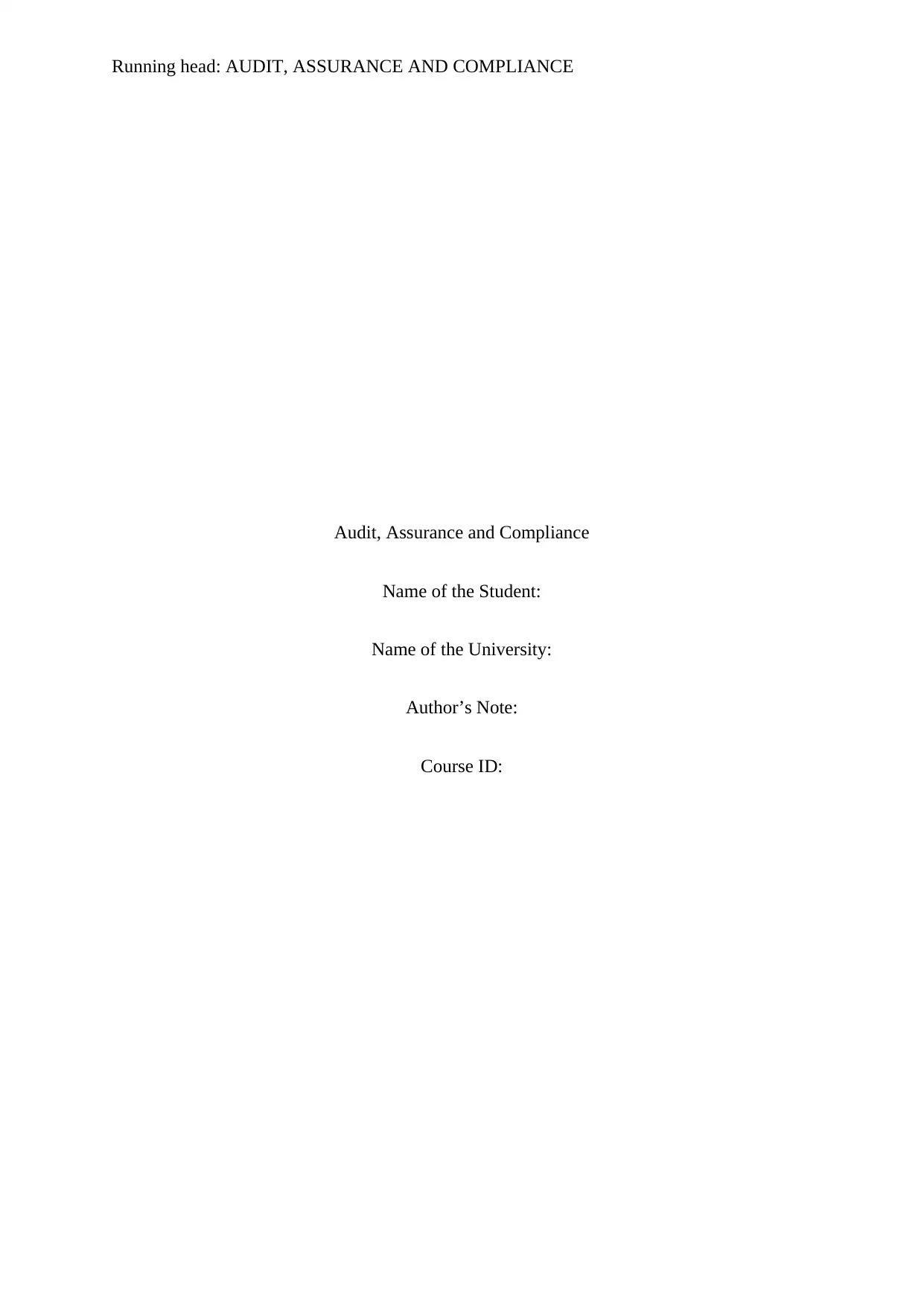
Running head: AUDIT, ASSURANCE AND COMPLIANCE
Audit, Assurance and Compliance
Name of the Student:
Name of the University:
Author’s Note:
Course ID:
Audit, Assurance and Compliance
Name of the Student:
Name of the University:
Author’s Note:
Course ID:
Paraphrase This Document
Need a fresh take? Get an instant paraphrase of this document with our AI Paraphraser
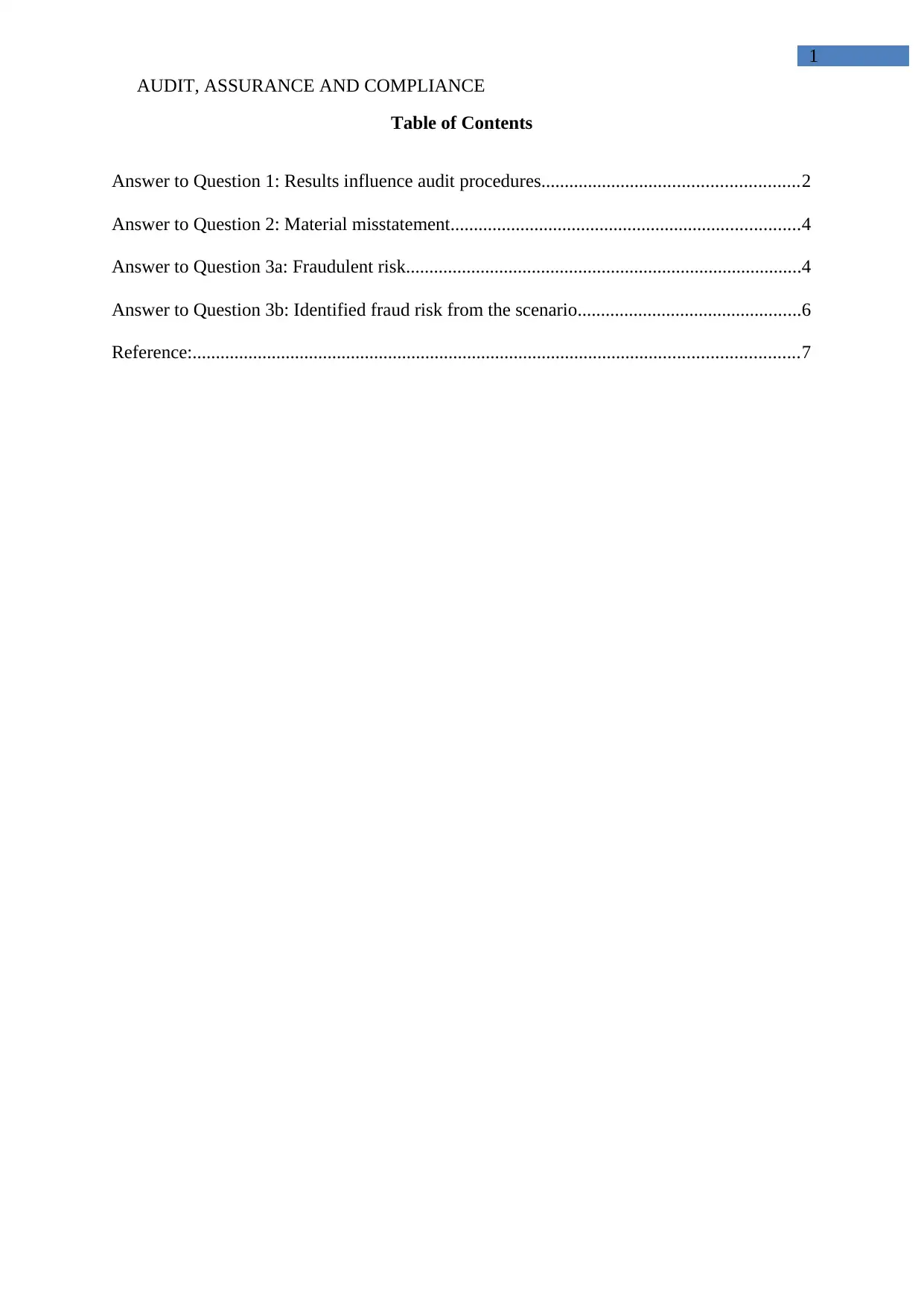
AUDIT, ASSURANCE AND COMPLIANCE
1
Table of Contents
Answer to Question 1: Results influence audit procedures.......................................................2
Answer to Question 2: Material misstatement...........................................................................4
Answer to Question 3a: Fraudulent risk.....................................................................................4
Answer to Question 3b: Identified fraud risk from the scenario................................................6
Reference:..................................................................................................................................7
1
Table of Contents
Answer to Question 1: Results influence audit procedures.......................................................2
Answer to Question 2: Material misstatement...........................................................................4
Answer to Question 3a: Fraudulent risk.....................................................................................4
Answer to Question 3b: Identified fraud risk from the scenario................................................6
Reference:..................................................................................................................................7
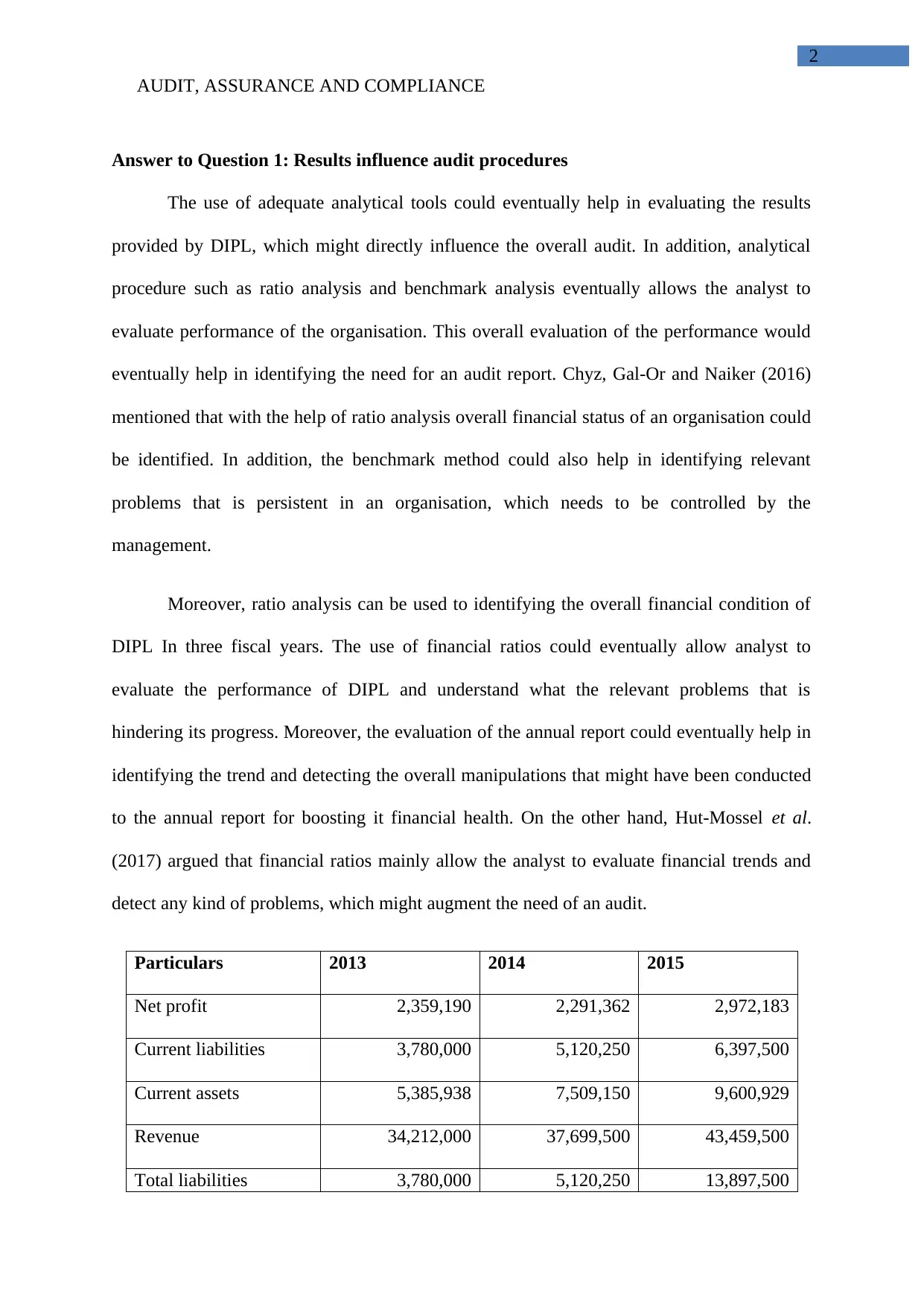
AUDIT, ASSURANCE AND COMPLIANCE
2
Answer to Question 1: Results influence audit procedures
The use of adequate analytical tools could eventually help in evaluating the results
provided by DIPL, which might directly influence the overall audit. In addition, analytical
procedure such as ratio analysis and benchmark analysis eventually allows the analyst to
evaluate performance of the organisation. This overall evaluation of the performance would
eventually help in identifying the need for an audit report. Chyz, Gal-Or and Naiker (2016)
mentioned that with the help of ratio analysis overall financial status of an organisation could
be identified. In addition, the benchmark method could also help in identifying relevant
problems that is persistent in an organisation, which needs to be controlled by the
management.
Moreover, ratio analysis can be used to identifying the overall financial condition of
DIPL In three fiscal years. The use of financial ratios could eventually allow analyst to
evaluate the performance of DIPL and understand what the relevant problems that is
hindering its progress. Moreover, the evaluation of the annual report could eventually help in
identifying the trend and detecting the overall manipulations that might have been conducted
to the annual report for boosting it financial health. On the other hand, Hut-Mossel et al.
(2017) argued that financial ratios mainly allow the analyst to evaluate financial trends and
detect any kind of problems, which might augment the need of an audit.
Particulars 2013 2014 2015
Net profit 2,359,190 2,291,362 2,972,183
Current liabilities 3,780,000 5,120,250 6,397,500
Current assets 5,385,938 7,509,150 9,600,929
Revenue 34,212,000 37,699,500 43,459,500
Total liabilities 3,780,000 5,120,250 13,897,500
2
Answer to Question 1: Results influence audit procedures
The use of adequate analytical tools could eventually help in evaluating the results
provided by DIPL, which might directly influence the overall audit. In addition, analytical
procedure such as ratio analysis and benchmark analysis eventually allows the analyst to
evaluate performance of the organisation. This overall evaluation of the performance would
eventually help in identifying the need for an audit report. Chyz, Gal-Or and Naiker (2016)
mentioned that with the help of ratio analysis overall financial status of an organisation could
be identified. In addition, the benchmark method could also help in identifying relevant
problems that is persistent in an organisation, which needs to be controlled by the
management.
Moreover, ratio analysis can be used to identifying the overall financial condition of
DIPL In three fiscal years. The use of financial ratios could eventually allow analyst to
evaluate the performance of DIPL and understand what the relevant problems that is
hindering its progress. Moreover, the evaluation of the annual report could eventually help in
identifying the trend and detecting the overall manipulations that might have been conducted
to the annual report for boosting it financial health. On the other hand, Hut-Mossel et al.
(2017) argued that financial ratios mainly allow the analyst to evaluate financial trends and
detect any kind of problems, which might augment the need of an audit.
Particulars 2013 2014 2015
Net profit 2,359,190 2,291,362 2,972,183
Current liabilities 3,780,000 5,120,250 6,397,500
Current assets 5,385,938 7,509,150 9,600,929
Revenue 34,212,000 37,699,500 43,459,500
Total liabilities 3,780,000 5,120,250 13,897,500
⊘ This is a preview!⊘
Do you want full access?
Subscribe today to unlock all pages.

Trusted by 1+ million students worldwide
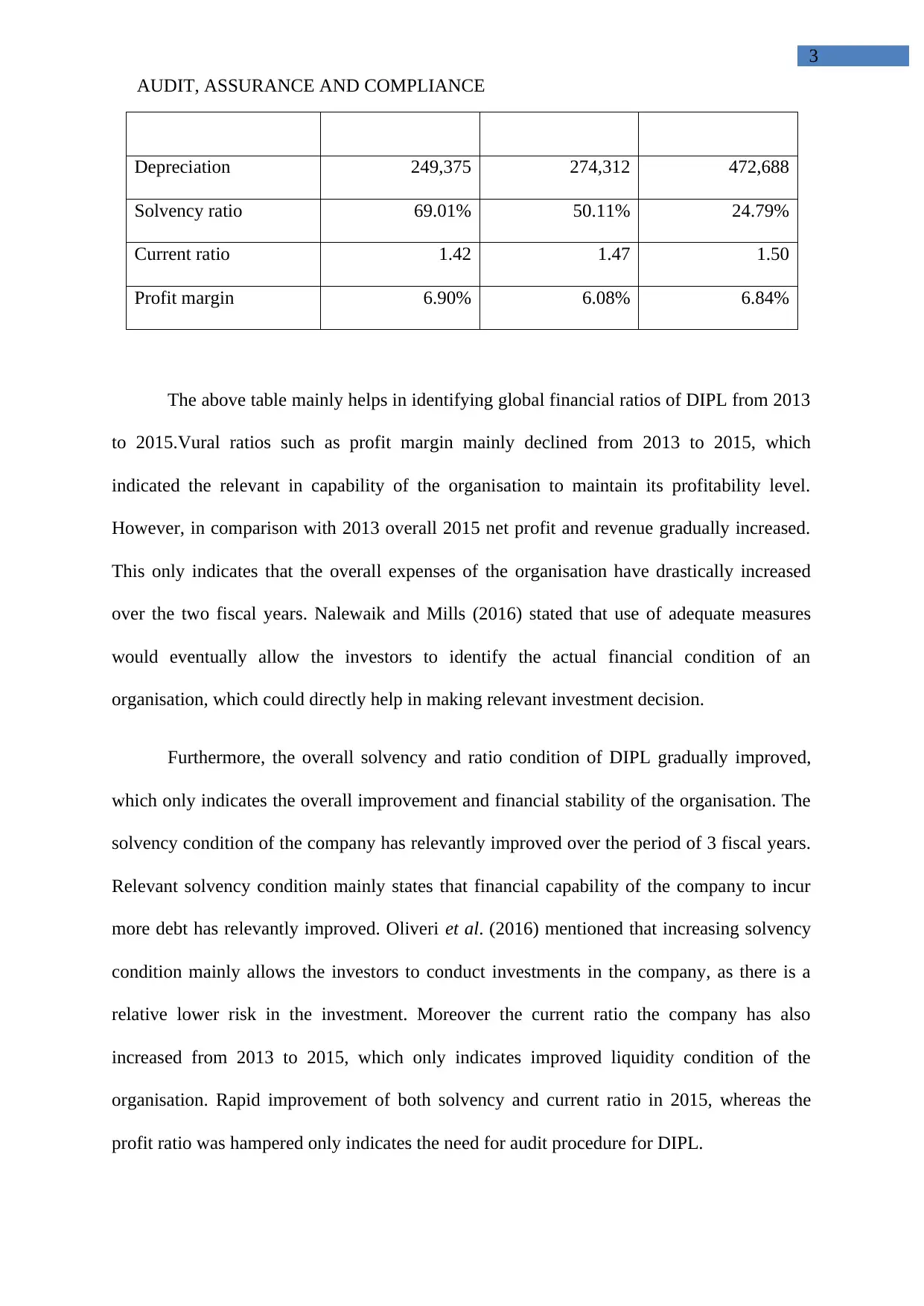
AUDIT, ASSURANCE AND COMPLIANCE
3
Depreciation 249,375 274,312 472,688
Solvency ratio 69.01% 50.11% 24.79%
Current ratio 1.42 1.47 1.50
Profit margin 6.90% 6.08% 6.84%
The above table mainly helps in identifying global financial ratios of DIPL from 2013
to 2015.Vural ratios such as profit margin mainly declined from 2013 to 2015, which
indicated the relevant in capability of the organisation to maintain its profitability level.
However, in comparison with 2013 overall 2015 net profit and revenue gradually increased.
This only indicates that the overall expenses of the organisation have drastically increased
over the two fiscal years. Nalewaik and Mills (2016) stated that use of adequate measures
would eventually allow the investors to identify the actual financial condition of an
organisation, which could directly help in making relevant investment decision.
Furthermore, the overall solvency and ratio condition of DIPL gradually improved,
which only indicates the overall improvement and financial stability of the organisation. The
solvency condition of the company has relevantly improved over the period of 3 fiscal years.
Relevant solvency condition mainly states that financial capability of the company to incur
more debt has relevantly improved. Oliveri et al. (2016) mentioned that increasing solvency
condition mainly allows the investors to conduct investments in the company, as there is a
relative lower risk in the investment. Moreover the current ratio the company has also
increased from 2013 to 2015, which only indicates improved liquidity condition of the
organisation. Rapid improvement of both solvency and current ratio in 2015, whereas the
profit ratio was hampered only indicates the need for audit procedure for DIPL.
3
Depreciation 249,375 274,312 472,688
Solvency ratio 69.01% 50.11% 24.79%
Current ratio 1.42 1.47 1.50
Profit margin 6.90% 6.08% 6.84%
The above table mainly helps in identifying global financial ratios of DIPL from 2013
to 2015.Vural ratios such as profit margin mainly declined from 2013 to 2015, which
indicated the relevant in capability of the organisation to maintain its profitability level.
However, in comparison with 2013 overall 2015 net profit and revenue gradually increased.
This only indicates that the overall expenses of the organisation have drastically increased
over the two fiscal years. Nalewaik and Mills (2016) stated that use of adequate measures
would eventually allow the investors to identify the actual financial condition of an
organisation, which could directly help in making relevant investment decision.
Furthermore, the overall solvency and ratio condition of DIPL gradually improved,
which only indicates the overall improvement and financial stability of the organisation. The
solvency condition of the company has relevantly improved over the period of 3 fiscal years.
Relevant solvency condition mainly states that financial capability of the company to incur
more debt has relevantly improved. Oliveri et al. (2016) mentioned that increasing solvency
condition mainly allows the investors to conduct investments in the company, as there is a
relative lower risk in the investment. Moreover the current ratio the company has also
increased from 2013 to 2015, which only indicates improved liquidity condition of the
organisation. Rapid improvement of both solvency and current ratio in 2015, whereas the
profit ratio was hampered only indicates the need for audit procedure for DIPL.
Paraphrase This Document
Need a fresh take? Get an instant paraphrase of this document with our AI Paraphraser
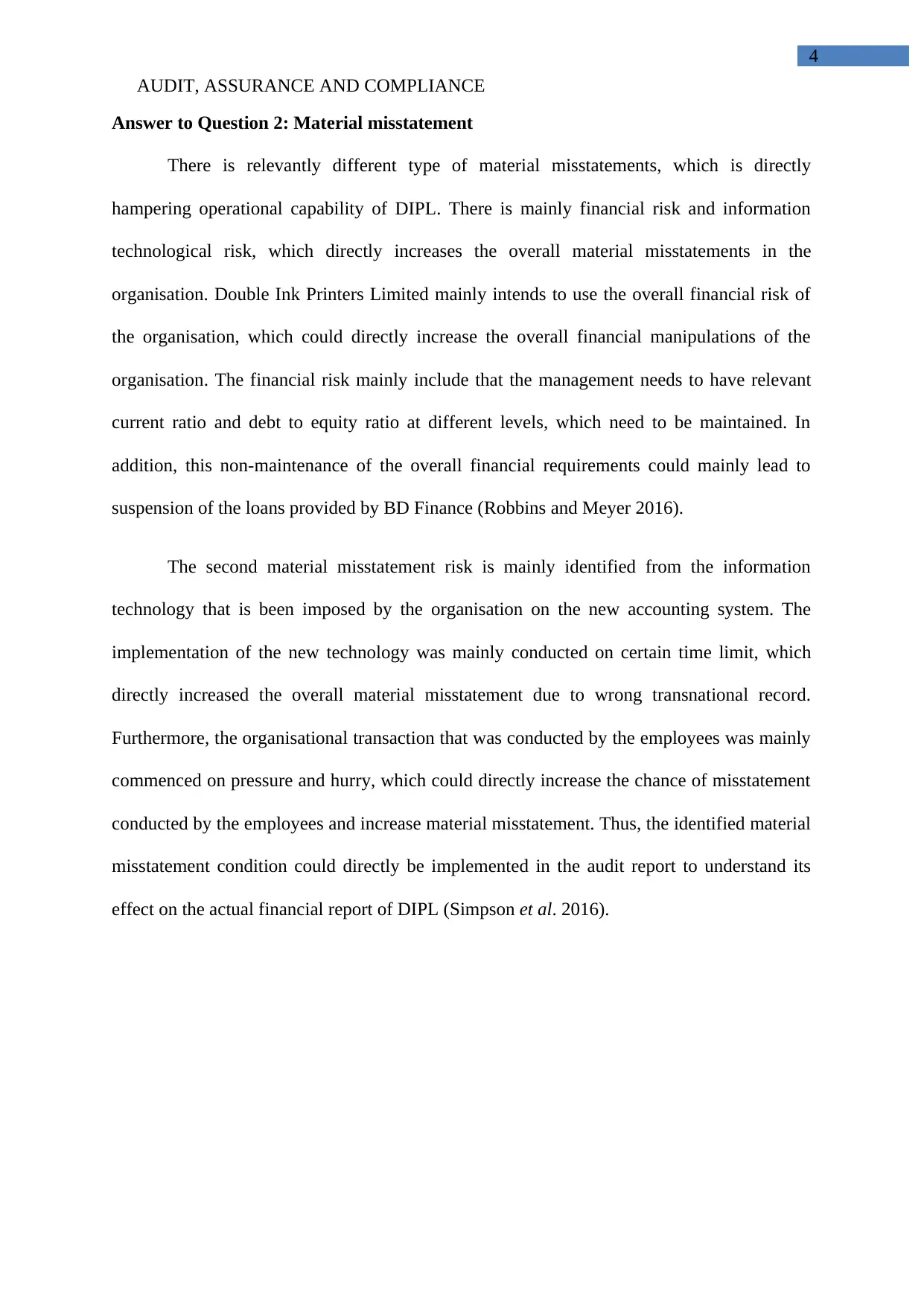
AUDIT, ASSURANCE AND COMPLIANCE
4
Answer to Question 2: Material misstatement
There is relevantly different type of material misstatements, which is directly
hampering operational capability of DIPL. There is mainly financial risk and information
technological risk, which directly increases the overall material misstatements in the
organisation. Double Ink Printers Limited mainly intends to use the overall financial risk of
the organisation, which could directly increase the overall financial manipulations of the
organisation. The financial risk mainly include that the management needs to have relevant
current ratio and debt to equity ratio at different levels, which need to be maintained. In
addition, this non-maintenance of the overall financial requirements could mainly lead to
suspension of the loans provided by BD Finance (Robbins and Meyer 2016).
The second material misstatement risk is mainly identified from the information
technology that is been imposed by the organisation on the new accounting system. The
implementation of the new technology was mainly conducted on certain time limit, which
directly increased the overall material misstatement due to wrong transnational record.
Furthermore, the organisational transaction that was conducted by the employees was mainly
commenced on pressure and hurry, which could directly increase the chance of misstatement
conducted by the employees and increase material misstatement. Thus, the identified material
misstatement condition could directly be implemented in the audit report to understand its
effect on the actual financial report of DIPL (Simpson et al. 2016).
4
Answer to Question 2: Material misstatement
There is relevantly different type of material misstatements, which is directly
hampering operational capability of DIPL. There is mainly financial risk and information
technological risk, which directly increases the overall material misstatements in the
organisation. Double Ink Printers Limited mainly intends to use the overall financial risk of
the organisation, which could directly increase the overall financial manipulations of the
organisation. The financial risk mainly include that the management needs to have relevant
current ratio and debt to equity ratio at different levels, which need to be maintained. In
addition, this non-maintenance of the overall financial requirements could mainly lead to
suspension of the loans provided by BD Finance (Robbins and Meyer 2016).
The second material misstatement risk is mainly identified from the information
technology that is been imposed by the organisation on the new accounting system. The
implementation of the new technology was mainly conducted on certain time limit, which
directly increased the overall material misstatement due to wrong transnational record.
Furthermore, the organisational transaction that was conducted by the employees was mainly
commenced on pressure and hurry, which could directly increase the chance of misstatement
conducted by the employees and increase material misstatement. Thus, the identified material
misstatement condition could directly be implemented in the audit report to understand its
effect on the actual financial report of DIPL (Simpson et al. 2016).
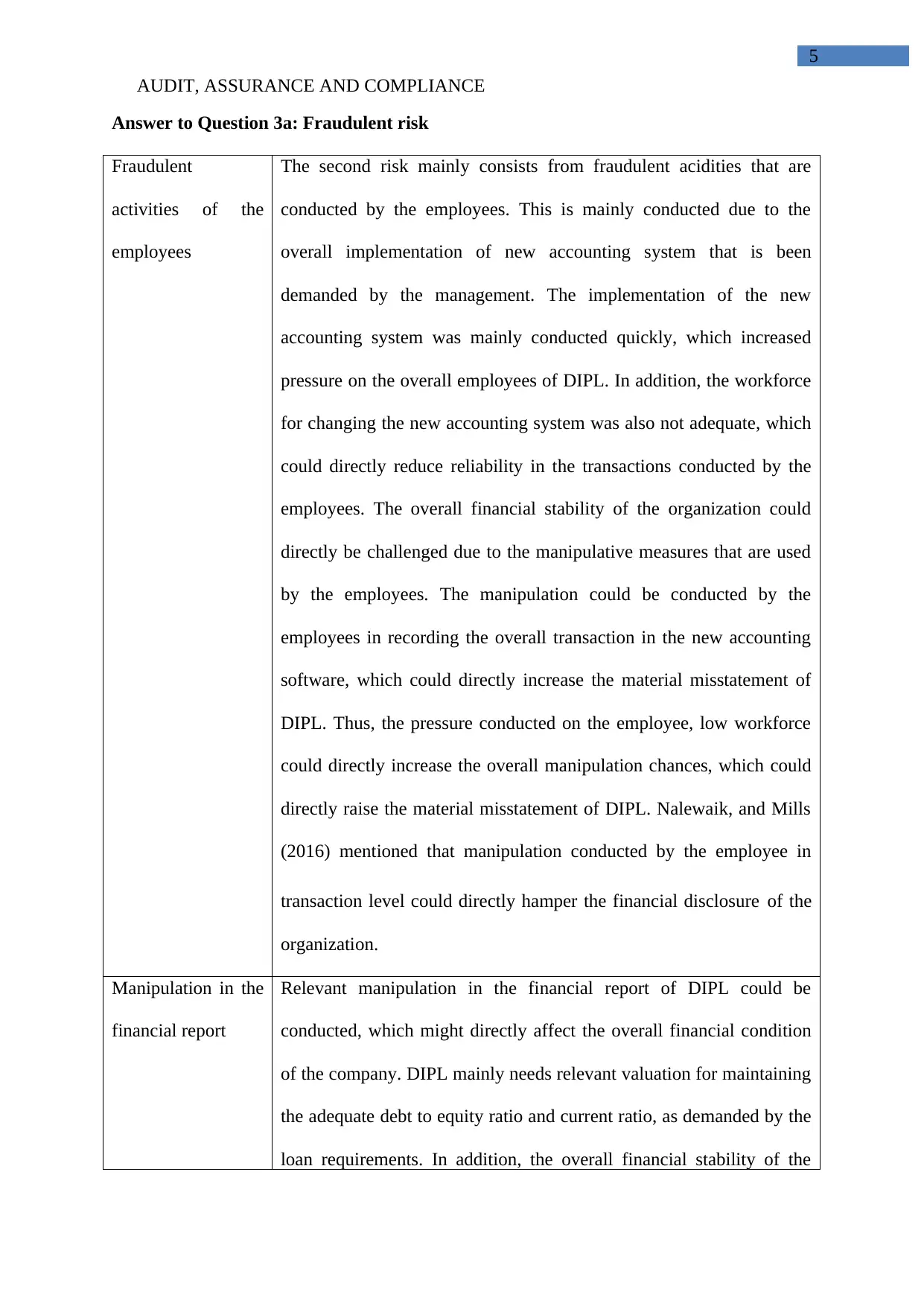
AUDIT, ASSURANCE AND COMPLIANCE
5
Answer to Question 3a: Fraudulent risk
Fraudulent
activities of the
employees
The second risk mainly consists from fraudulent acidities that are
conducted by the employees. This is mainly conducted due to the
overall implementation of new accounting system that is been
demanded by the management. The implementation of the new
accounting system was mainly conducted quickly, which increased
pressure on the overall employees of DIPL. In addition, the workforce
for changing the new accounting system was also not adequate, which
could directly reduce reliability in the transactions conducted by the
employees. The overall financial stability of the organization could
directly be challenged due to the manipulative measures that are used
by the employees. The manipulation could be conducted by the
employees in recording the overall transaction in the new accounting
software, which could directly increase the material misstatement of
DIPL. Thus, the pressure conducted on the employee, low workforce
could directly increase the overall manipulation chances, which could
directly raise the material misstatement of DIPL. Nalewaik, and Mills
(2016) mentioned that manipulation conducted by the employee in
transaction level could directly hamper the financial disclosure of the
organization.
Manipulation in the
financial report
Relevant manipulation in the financial report of DIPL could be
conducted, which might directly affect the overall financial condition
of the company. DIPL mainly needs relevant valuation for maintaining
the adequate debt to equity ratio and current ratio, as demanded by the
loan requirements. In addition, the overall financial stability of the
5
Answer to Question 3a: Fraudulent risk
Fraudulent
activities of the
employees
The second risk mainly consists from fraudulent acidities that are
conducted by the employees. This is mainly conducted due to the
overall implementation of new accounting system that is been
demanded by the management. The implementation of the new
accounting system was mainly conducted quickly, which increased
pressure on the overall employees of DIPL. In addition, the workforce
for changing the new accounting system was also not adequate, which
could directly reduce reliability in the transactions conducted by the
employees. The overall financial stability of the organization could
directly be challenged due to the manipulative measures that are used
by the employees. The manipulation could be conducted by the
employees in recording the overall transaction in the new accounting
software, which could directly increase the material misstatement of
DIPL. Thus, the pressure conducted on the employee, low workforce
could directly increase the overall manipulation chances, which could
directly raise the material misstatement of DIPL. Nalewaik, and Mills
(2016) mentioned that manipulation conducted by the employee in
transaction level could directly hamper the financial disclosure of the
organization.
Manipulation in the
financial report
Relevant manipulation in the financial report of DIPL could be
conducted, which might directly affect the overall financial condition
of the company. DIPL mainly needs relevant valuation for maintaining
the adequate debt to equity ratio and current ratio, as demanded by the
loan requirements. In addition, the overall financial stability of the
⊘ This is a preview!⊘
Do you want full access?
Subscribe today to unlock all pages.

Trusted by 1+ million students worldwide
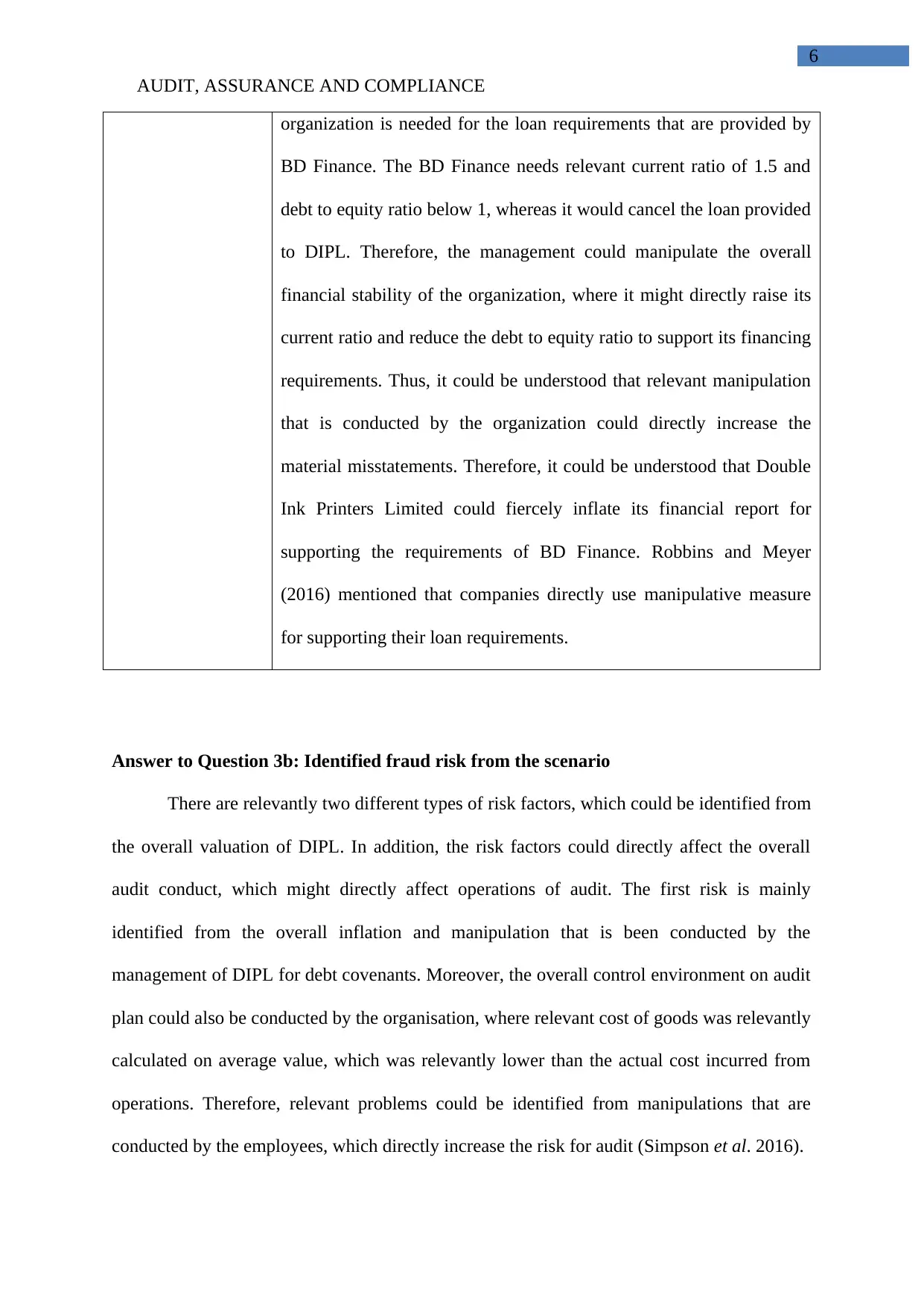
AUDIT, ASSURANCE AND COMPLIANCE
6
organization is needed for the loan requirements that are provided by
BD Finance. The BD Finance needs relevant current ratio of 1.5 and
debt to equity ratio below 1, whereas it would cancel the loan provided
to DIPL. Therefore, the management could manipulate the overall
financial stability of the organization, where it might directly raise its
current ratio and reduce the debt to equity ratio to support its financing
requirements. Thus, it could be understood that relevant manipulation
that is conducted by the organization could directly increase the
material misstatements. Therefore, it could be understood that Double
Ink Printers Limited could fiercely inflate its financial report for
supporting the requirements of BD Finance. Robbins and Meyer
(2016) mentioned that companies directly use manipulative measure
for supporting their loan requirements.
Answer to Question 3b: Identified fraud risk from the scenario
There are relevantly two different types of risk factors, which could be identified from
the overall valuation of DIPL. In addition, the risk factors could directly affect the overall
audit conduct, which might directly affect operations of audit. The first risk is mainly
identified from the overall inflation and manipulation that is been conducted by the
management of DIPL for debt covenants. Moreover, the overall control environment on audit
plan could also be conducted by the organisation, where relevant cost of goods was relevantly
calculated on average value, which was relevantly lower than the actual cost incurred from
operations. Therefore, relevant problems could be identified from manipulations that are
conducted by the employees, which directly increase the risk for audit (Simpson et al. 2016).
6
organization is needed for the loan requirements that are provided by
BD Finance. The BD Finance needs relevant current ratio of 1.5 and
debt to equity ratio below 1, whereas it would cancel the loan provided
to DIPL. Therefore, the management could manipulate the overall
financial stability of the organization, where it might directly raise its
current ratio and reduce the debt to equity ratio to support its financing
requirements. Thus, it could be understood that relevant manipulation
that is conducted by the organization could directly increase the
material misstatements. Therefore, it could be understood that Double
Ink Printers Limited could fiercely inflate its financial report for
supporting the requirements of BD Finance. Robbins and Meyer
(2016) mentioned that companies directly use manipulative measure
for supporting their loan requirements.
Answer to Question 3b: Identified fraud risk from the scenario
There are relevantly two different types of risk factors, which could be identified from
the overall valuation of DIPL. In addition, the risk factors could directly affect the overall
audit conduct, which might directly affect operations of audit. The first risk is mainly
identified from the overall inflation and manipulation that is been conducted by the
management of DIPL for debt covenants. Moreover, the overall control environment on audit
plan could also be conducted by the organisation, where relevant cost of goods was relevantly
calculated on average value, which was relevantly lower than the actual cost incurred from
operations. Therefore, relevant problems could be identified from manipulations that are
conducted by the employees, which directly increase the risk for audit (Simpson et al. 2016).
1 out of 7
Related Documents
Your All-in-One AI-Powered Toolkit for Academic Success.
+13062052269
info@desklib.com
Available 24*7 on WhatsApp / Email
![[object Object]](/_next/static/media/star-bottom.7253800d.svg)
Unlock your academic potential
Copyright © 2020–2025 A2Z Services. All Rights Reserved. Developed and managed by ZUCOL.





